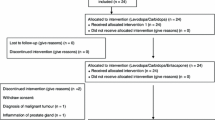Summary
Inhibitors of the enzyme catechol-O-methyl transferase (COMT) may be useful adjuncts to L-DOPA in the treatment of Parkinson's disease as they offer the possibility of increasing the availability of the amino acid. It is unknown whether a COMT inhibitor which penetrates the blood-brain barrier is preferable to one restricted to extra-cerebral inhibition. We measured liver and brain COMT activity two hours following administration of two COMT inhibitors: entacapone (ENT), mainly peripherally acting, and dinitrocatechol (DNC), peripheral and central acting. As expected, the full spectrum inhibitor DNC (30 mg/kg) induced a near total inhibition of liver and brain COMT activity. Unexpectedly, however, ENT, at 30 mg/kg, produced the same degree of liverand brain COMT inhibition as DNC; using 10 mg/kg, ENT still inhibited both liver and brain COMT activity by 80%. Only at 2.5 and 5 mg/kg did ENT achieve a differential inhibition of liver (80% inhibition) versus brain (10–30% inhibition) COMT activity. In a second series of experiments, we administered ENT (2.5,10, and 30 mg/kg) and DNC (30 mg/kg) to rats and monitored extracellular striatal dopamine and dopamine metabolite levels with cerebral microdialysis both under basal conditions and following L-DOPA/carbidopa administration. No compound modified basal striatal levels of dopamine. ENT at 30 mg/kg (but not 2.5 or 10 mg), as well as DNC, decreased striatal levels of the methylated dopamine metabolite homovanillic acid (HVA). When L-DOPA/carbidopa was administered, dopamine formation was greatest and HVA formation least in animals pretreated with DNC and 30 mg/kg ENT (but not 2.5 or 10 mg/kg ENT). The finding that ENT at doses relatively specific for peripheral enzyme inhibition did not promote dopamine or inhibit HVA formation is most likely due to the 20% residual liver COMT activity present when the inhibitor was used at less than full doses. Our data indicate that DNC and ENT both inhibit striatal HVA formation and increase dopamine formation from exogenously administered L-DOPA. The dopamine promoting effect of ENT is only present, however, at doses which inhibit central as well as peripheral COMT activity.
Similar content being viewed by others
References
Brannan T, Martínez-Tica J, Yahr MD (1991) Effect of dietary protein on striatal dopamine formation following L-DOPA administration: an in vivo study. Neuropharmacology 30: 1125–1127
Brannan T, Martínez-Tica J, Yahr MD (1992) Catechol-O-methyltransferase inhibition increases striatal L-DOPA and dopamine: an in vivo study in rats. Neurology 42: 683–685
Brannan T, Martínez-Tica J, Yahr MD (1992) Changes in body temperature markedly affect striatal dopamine release and metabolism: an in vivo study. J Neural Transm [Gen Sect] 89: 193–196
Kaakkola S, Wurtman RJ (1992) Effects of COMT inhibitors on striatal dopamine metabolism: a microdialysis study. Brain Res 587: 241–249
Kaakkola S, Wurtman RJ (1993) Effects of catechol-O-methyltransferase inhibitors and L-3,4-dihydroxyphenylalanine with or without carbidopa on extracellular dopamine in rat striatum. J Neurochem 60(1): 137–144
Kaakkola S, Gordin A, Männisto PT (1994) General properties and clinical possibilities of new selective inhibitors of catechol O-methyltransferase. Gen Pharmac 25: 813–824
Kaakkola S, Teravainen H, Ahtila S, Rita H, Gordin A (1994) Effect of entacapone, a COMT inhibitor, on clinical disability and levodopa metabolism in parkinsonian patients. Neurology 44(1): 77–8
Kaakkola S, Teravainen H, Ahtila S, Karlsson M, Naukkarinen T, Rita H, Gordin A (1995) Entacapone in combination with standrd or controlled-release levodopa/carbidopa: a clinical and pharmacokinetic study in patients with Parkinson's disease. Eur J Neurol 2: 1–7
Maj J, Rogóz G, Skuza G, Sowínska H, Superata J (1990) Behavioral and neurochemical effects of Ro 40-7592, a new COMT inhititor with a potential therapeutic activity in Parkinson's disease. J Neural Transm [P-D Sect] 2: 101–112
Männistö PT, Toumainen P, Tuominen RK (1992) Different in vivo properties of three new inhibitors of catechol-O-methyltransferase. Br J Pharmacol 105: 569–574
Mena MA, Muradas V, Bazan E, Reintz J, de Yebenez JG (1987) Pharmacokinetics of L-DOPA in patients with Parkinson's disease. In: Yahr MD, Bergmann KJ (eds) Parkinson's disease. Raven Press, New York, pp 481–492 (Adv Neurol 45)
Merello M, Lees AJ, Webster R, Bovingdon M, Gordin A (1994) Effect of entacapone, a peripherally acting catechol-O-methyltransferase inhibitor, on the motor response to acute treatment with levodopa in patients with Parkinson's disease. J Neurol Neurosurg Psychiatry 57(2): 186–9
Nissinen E, Linden IB, Schultz E, Kaakkola S, Männisto PT, Pohto P (1988) Inhibition of catechol-O-methyltransferase activity by two novel disubstituted catechols in the rat. Eur J Pharmacol 153: 263–269
Nissinen E, Linden IB, Schultz E, Pohto P (1992) Biochemical and pharmacological properties of a peripherally acting catechol-O-methyltransferase inhibitor entacapone. Naunyn Schmiedebergs Arch Pharmacol 346(3): 262–6
Nutt JG, Woodward WR, Beckner RM, Stone CK, Berggren K, Carter JH, Gancher ST, Hammerstad JP, Gordin A (1994) Effect of peripheral catechol-O-methyltransferase inhibition on the pharmacokinetics and pharmacodynamics of levodopa in parkinsonian patients. Neurology 44(5): 913–9
Roberts JW, Cora-Locatelli G, Bravi D, Amantea MA, Mouradian MM, Chase TN (1983) Catechol-O-methyl transferase inhibitor tolcapone prolongs levodopa/carbidopa action in parkinson patients. Neurology 43: 2685–2688
Schultz E, Nissinen E, Kaakkola S (1989) Determination of catechol-O-methyltransferase activity in erythrocytes by high performance liquid chromatography with electrochemical detection. Biomed Chromatogr 3: 64–67
Shoup RE, Davis GC, Kissinger PT (1980) Determination of catechol-O-methyltransferase activity in various tissues by liquid chromatography. Anal Chem 52: 483–487
Törnwall M, Tuomainen P, Männisto PT (1992) Neurochemical and psychomotor interadctions of new selective COMT inhibitors with clorgyline and nomifensene in levodopa-treated rats and mice. Arch Int Pharmacodyn 320: 5–20
Törnwall M, Tuomainen P, Männisto PT (1993) Modulation of rat brain endogenous dopamine metabolism by new inhibitors of catechol-O-methyltransferase. Eur J Pharmacol 239: 39–45
Törnwall M, Kaakkola S, Tuomainen P, Kask A, Männisto PT (1994) Comparison of two new inhibitors of catechol-O-methylation on striatal dopamine metabolism: a microdialysis study. Br J Pharmacol 112: 13–18
Author information
Authors and Affiliations
Rights and permissions
About this article
Cite this article
Brannan, T., Prikhojan, A. & Yahr, M.D. Peripheral and central inhibitors of catechol-O-methyl transferase: effects on liver and brain COMT activity and L-DOPA metabolism. J. Neural Transmission 104, 77–87 (1997). https://doi.org/10.1007/BF01271296
Received:
Accepted:
Issue Date:
DOI: https://doi.org/10.1007/BF01271296




